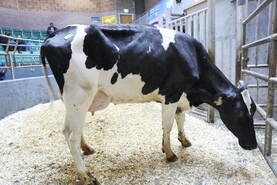Ireland’s livestock marts continue to enjoy a much busier period of trading with bovine throughput for the first six months of the year increasing by 106,381 head, or 12.3%, on 2021 levels and exceeding the 1m head mark. This includes 968,665 animals traded and 47,131 animals which were shown but not sold, with the latter figure reducing by 7,163 head on 2021 levels.
Throughput in May and June followed the normal seasonal decline but held consistent with the higher throughput figures witnessed in quarter one and increased by 17,527 head (+12.5%) and 20,786 head (+23%), respectively.
Reports indicate that the higher throughput levels in 2022 have been helped by a buoyant live trade for slaughter-fit stock, higher numbers of calves appearing in sales and the trade returning to normal after two years of coronavirus-related disruption.
Marts in Munster remain well out in front in terms of throughput and account for 495,442 head, or 49% of total throughput in 2022. This is over twice the level of any of the other three provinces with 229,142 animals offered for sale in marts in Leinster, 189,474 head in Connacht and 101,738 head in Cavan, Donegal and Monaghan.
Farm-to-farm throughput
In contrast farm-to-farm movements of bovines for the first half of 2022 fell by 83,846 head, or 8.3%, on 2021 levels and were recorded at 924,264 head.
The greatest year-on-year change occurred in April with the figure of 203,012 head falling 44,003 head.
Movements of 155,073 head in May were 13,178 head lower, while there was little change in June with movements of 85,296 head running 4,238 head lower.
Similar to mart throughput, farmers in Munster dominated farm-to-farm movements accounting for some 472,473 bovines changing farms or 51% of all movements. This is underpinned by the high population of dairy animals in Munster with farm-to-farm movements of milking stock more common than trading through marts.
There were 277,523 movements recorded in Leinster, 110,251 in Connacht and 64,017 in Ulster marts.
Ireland’s livestock marts continue to enjoy a much busier period of trading with bovine throughput for the first six months of the year increasing by 106,381 head, or 12.3%, on 2021 levels and exceeding the 1m head mark. This includes 968,665 animals traded and 47,131 animals which were shown but not sold, with the latter figure reducing by 7,163 head on 2021 levels.
Throughput in May and June followed the normal seasonal decline but held consistent with the higher throughput figures witnessed in quarter one and increased by 17,527 head (+12.5%) and 20,786 head (+23%), respectively.
Reports indicate that the higher throughput levels in 2022 have been helped by a buoyant live trade for slaughter-fit stock, higher numbers of calves appearing in sales and the trade returning to normal after two years of coronavirus-related disruption.
Marts in Munster remain well out in front in terms of throughput and account for 495,442 head, or 49% of total throughput in 2022. This is over twice the level of any of the other three provinces with 229,142 animals offered for sale in marts in Leinster, 189,474 head in Connacht and 101,738 head in Cavan, Donegal and Monaghan.
Farm-to-farm throughput
In contrast farm-to-farm movements of bovines for the first half of 2022 fell by 83,846 head, or 8.3%, on 2021 levels and were recorded at 924,264 head.
The greatest year-on-year change occurred in April with the figure of 203,012 head falling 44,003 head.
Movements of 155,073 head in May were 13,178 head lower, while there was little change in June with movements of 85,296 head running 4,238 head lower.
Similar to mart throughput, farmers in Munster dominated farm-to-farm movements accounting for some 472,473 bovines changing farms or 51% of all movements. This is underpinned by the high population of dairy animals in Munster with farm-to-farm movements of milking stock more common than trading through marts.
There were 277,523 movements recorded in Leinster, 110,251 in Connacht and 64,017 in Ulster marts.






 This is a subscriber-only article
This is a subscriber-only article










SHARING OPTIONS: